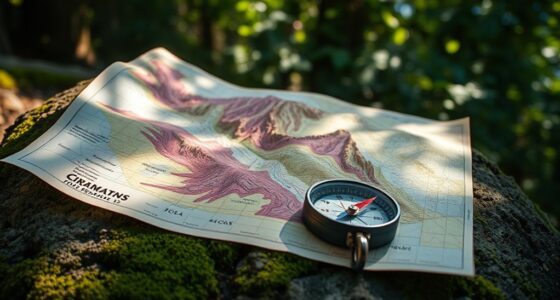Leave No Trace principles guide you to enjoy nature responsibly by planning ahead, staying on durable surfaces, and properly disposing of waste. You should leave natural features undisturbed and keep fires small and safely extinguished. Respect wildlife and other visitors by keeping noise low and giving animals space. Practice responsible photography, avoid damaging plants, and advocate for conservation. Following these guidelines helps protect the environment, and if you continue, you’ll learn how to apply them effectively.
Key Takeaways
- Leave No Trace principles guide responsible outdoor ethics to minimize environmental impact and preserve natural areas for future enjoyment.
- They include planning ahead, respecting wildlife, disposing of waste properly, and staying on durable surfaces.
- Protect natural features by leaving rocks, plants, and artifacts undisturbed.
- Minimize campfire impact by using designated fire rings, keeping fires small, and fully extinguishing fires.
- Respect other visitors and wildlife by keeping noise low, maintaining distance, and practicing cultural sensitivity.
Plan Ahead and Prepare

Planning ahead and preparing before your trip helps guarantee a safe, enjoyable experience while minimizing your environmental impact. By following Leave No Trace ethics, you can reduce your footprint and protect natural areas. Research the weather, trail conditions, and regulations beforehand to avoid surprises and ensure outdoor safety. Pack essential gear, including navigational tools, extra clothing, and first aid supplies, to handle emergencies confidently. Being well-prepared also means understanding the rules about camping, fires, and waste disposal. This proactive approach prevents damage to the environment and keeps you safe during your adventure. Remember, thoughtful planning isn’t just about your safety; it’s about respecting the land and helping preserve it for future visitors. Your preparation makes a difference.
Travel and Camp on Durable Surfaces

When you’re exploring natural areas, sticking to designated trails and campsites helps protect the environment. Walking on durable surfaces minimizes trail erosion and soil compaction, which can harm plant roots and disturb wildlife. Using established paths keeps vegetation intact and prevents widening of trails. Camp on durable surfaces like rock, gravel, or compacted soil, avoiding fragile vegetation or loose soil that can easily erode. Here’s a quick guide:
| Surface Type | Benefits | Tips |
|---|---|---|
| Rock | Durable, stable | Use existing campsites |
| Gravel | Resistant to erosion | Avoid soft ground |
| Compact Soil | Reduces trail damage | Stay on marked routes |
Additionally, choosing sustainable camping practices helps ensure that natural areas remain pristine for future visitors.
Dispose of Waste Properly

When you finish your trip, make sure to pack out all remnants of your waste to leave the area clean. Use designated bins for trash and recycling whenever you can, so waste doesn’t harm the environment. Proper disposal helps keep natural spaces safe and enjoyable for everyone. Incorporating Leave No Trace principles can further minimize your impact on the environment during outdoor activities.
Pack It Out Remnants
To preserve the natural beauty of your surroundings, always pack out all waste remnants, including trash, food scraps, and toilet paper. Proper remnant collection is essential to prevent pollution and protect wildlife. When you finish your activity, gather all waste and guarantee nothing is left behind. Waste removal should be thorough, leaving the area as pristine as you found it. Use designated bags or containers to carry out trash and scraps, and double-check the area for any overlooked debris. Remember that even small remnants can impact the environment over time. By taking responsibility for waste removal, you help maintain the integrity of natural spaces for others to enjoy. Your careful effort ensures these places stay beautiful and undisturbed for future visitors. Incorporating proper waste management practices is vital to reducing environmental impact and ensuring the longevity of protected areas.
Use Designated Bins
After gathering all waste remnants and ensuring nothing is left behind, it’s important to dispose of them properly. Using designated bins helps maintain effective trash disposal and supports responsible waste management. Always look for trash receptacles provided at your site; these are specifically meant to handle waste safely and prevent environmental harm. Avoid littering by properly disposing of wrappers, food scraps, and other refuse. If bins are full, pack your waste out or find an alternative container. Proper waste management reduces pollution, protects wildlife, and keeps natural areas pristine. Additionally, bike maintenance routines, such as checking your tires and drivetrain, can prevent environmental hazards caused by leaks or debris. Remember, leaving waste in designated bins is a simple yet essential step in practicing Leave No Trace principles. Your efforts ensure future visitors can enjoy the environment just as much as you do.
Leave What You Find
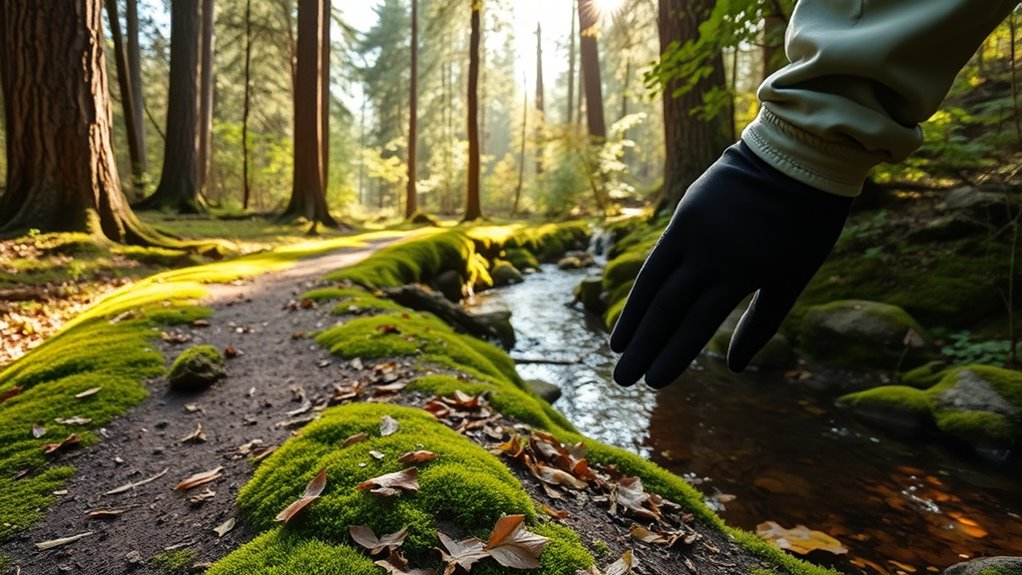
When exploring natural areas, you should leave everything as you found it to protect the environment. Avoid removing rocks, plants, or artifacts that might be part of the landscape’s story. By doing so, you help preserve natural features and prevent damage to important cultural or historical items.
Preserve Natural Features
Preserving natural features means you should leave what you find exactly as it is, without removing or disturbing plants, rocks, or artifacts. This practice supports natural feature preservation and helps maintain the area’s geological integrity. When you respect these features, you prevent erosion, protect habitats, and keep landscapes looking pristine for future visitors. Avoid taking rocks, plants, or other natural objects, as doing so can disrupt the environment’s balance. Your actions help preserve the beauty and scientific value of natural features, ensuring they remain unchanged for others to enjoy and study. Remember, the goal is to minimize your impact by leaving everything as you found it, so the environment stays healthy and intact for generations to come. Proper preservation methods also include avoiding unnecessary contact with natural elements, which helps prevent damage and ensures the landscape remains undisturbed for ongoing conservation.
Minimize Impact on Artifacts
To help protect artifacts at natural sites, you should leave everything as you find it, rather than touching, moving, or collecting them. This practice supports artifact preservation and respects the cultural sensitivity of the area. Handling artifacts can cause damage or deterioration, making them inaccessible for future study and enjoyment. When you leave artifacts undisturbed, you help maintain their historical and cultural significance. Always avoid taking souvenirs, as removing artifacts can be illegal and disrespectful. By observing these guidelines, you ensure that others can appreciate the site’s history and cultural importance. Remember, your role is to preserve the integrity of the site for future visitors and researchers. Practicing responsible behavior helps keep natural and cultural sites authentic and meaningful. Integration with conservation efforts enhances the overall effectiveness of preservation strategies.
Minimize Campfire Impact
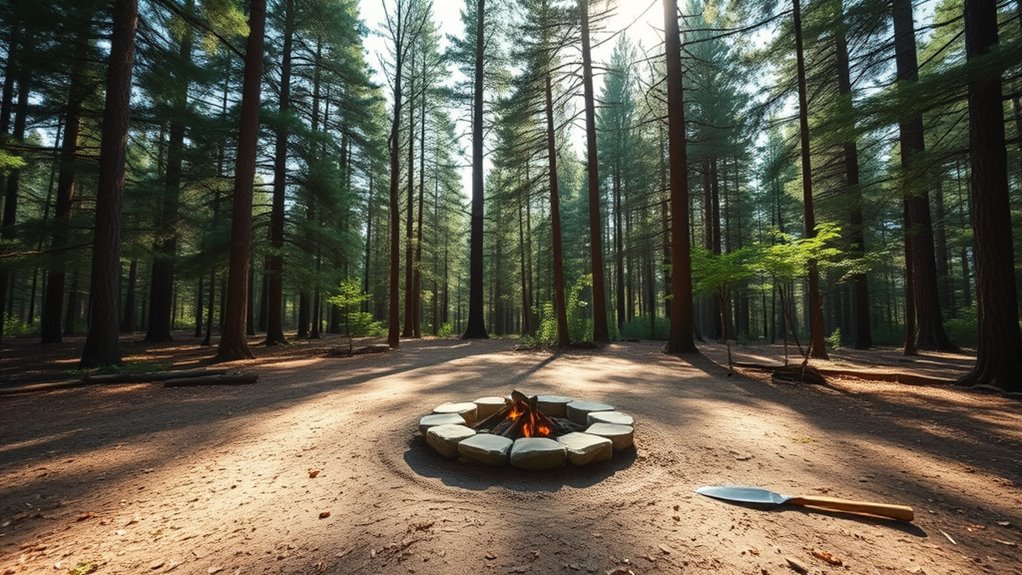
Campfires can pose significant environmental risks if not managed carefully, so it’s important to minimize their impact. Practice good campfire safety by keeping fires small and manageable. Always use a designated fire ring or a prepared fire pit to contain the flames and prevent the fire from spreading. Clear away any flammable materials like leaves, grass, or twigs from around the fire area before you start. When you’re done, extinguish the fire completely by pouring water over it, stirring the ashes, and ensuring that everything is cool to the touch. Avoid building new fires on fragile surfaces or in areas prone to erosion. Be aware of local regulations and fire bans to help prevent wildfires and protect the environment. By following these steps, you help protect the environment and ensure everyone can enjoy the outdoors safely.
Respect Wildlife
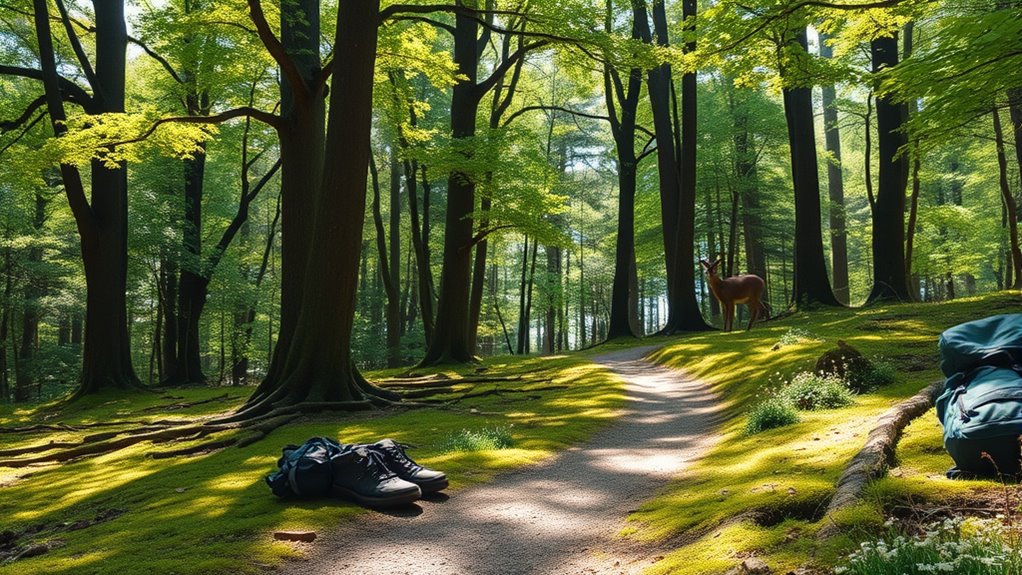
Respecting wildlife is key to maintaining the health and balance of natural habitats. You should observe animals from a distance to avoid disturbing their natural behaviors. Feeding wildlife is tempting, but it can lead to dependency and disrupt their natural foraging. Be mindful of flora disturbance; avoid trampling plants or nesting sites that could harm ecosystems. Keep noise levels down to prevent stressing animals and causing unnecessary retreat. Respecting their space helps prevent habituation, which can make wildlife vulnerable to danger or disease. Additionally, choosing appropriate dog names that reflect the breed’s personality can help foster a respectful bond and promote positive interactions with wildlife.
Be Considerate of Other Visitors
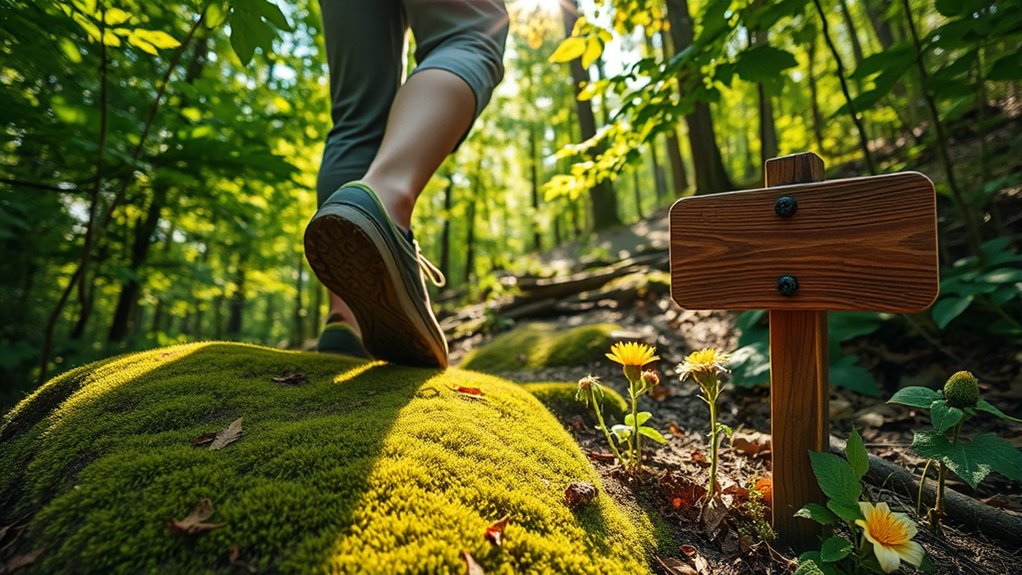
How can you guarantee everyone enjoys their outdoor experience? By being considerate of other visitors, you help create a positive atmosphere. Keep noise pollution to a minimum so that conversations, wildlife, and the natural sounds remain undisturbed. Avoid loud noises, shouting, or playing music that could disturb others or wildlife nearby. Respect quiet areas and give fellow visitors space to enjoy solitude. Remember, wildlife disturbance can occur if you’re too loud or intrusive, which can harm animals and ruin their natural behaviors. Keep your voices low and avoid sudden movements. Being mindful of your noise levels and respecting others’ presence ensures everyone can experience the tranquility and beauty of the outdoors. Your consideration makes outdoor spaces enjoyable and peaceful for everyone. Additionally, staying informed about wildlife disturbance and how to minimize it can further enhance everyone’s outdoor experience.
Practice Responsible Photography and Cultural Respect

While being considerate of other visitors helps maintain a peaceful atmosphere, it’s equally important to practice responsible photography and cultural respect during your outdoor adventures. When capturing wildlife photography, prioritize the well-being of animals by maintaining a safe distance and avoiding disturbances. Respect local cultures by learning about customs and asking permission before photographing people or sacred sites. Avoid taking photos that could be intrusive or disrespectful, and never use flash around wildlife or sensitive areas. Remember, your images can influence perceptions; show cultural sensitivity by refraining from stereotypes or misrepresentations. Additionally, understanding the importance of educational toys can promote a more respectful and engaging learning environment for children during outdoor activities.
Educate and Advocate for Responsible Outdoor Ethics

Educating others and advocating for responsible outdoor ethics are essential steps in preserving natural spaces for future generations. By sharing Leave No Trace ethics, you help foster a culture of outdoor conservation. Encourage fellow adventurers to minimize their impact, follow proper waste disposal, and respect wildlife. Use the table below to highlight key actions:
| Action | Why it Matters | How to Practice |
|---|---|---|
| Leave No Trace principles | Protects ecosystems | Pack out all trash |
| Respect wildlife | Preserves natural behavior | Keep a safe distance |
| Stay on trails | Prevents habitat damage | Follow marked paths |
| Advocate for conservation | Ensures ongoing preservation | Support policies and education |
Frequently Asked Questions
How Do I Handle Unexpected Weather Changes While Following Leave No Trace?
When unexpected weather changes occur, stay weather prepared and adapt your gear accordingly. You should quickly secure loose items, protect your shelter, and minimize impact by choosing durable, eco-friendly gear that withstands the elements. Avoid creating new trails or damage, and pack out all waste. Being flexible and ready with weather preparedness and gear adaptability helps you follow Leave No Trace principles, ensuring nature stays pristine for others.
What Gear Is Essential for Sustainable Camping Practices?
You should pack sustainable camping gear like biodegradable soap, reusable utensils, and eco-friendly tents to minimize your impact. Lightweight, durable gear reduces waste and environmental strain. Invest in sustainable equipment such as solar-powered chargers and insulated water bottles to lessen reliance on disposable items. These essentials help you enjoy nature responsibly, ensuring you leave no trace behind while staying comfortable and prepared during your outdoor adventures.
How Can I Teach Children About Leave No Trace Principles Effectively?
You can teach children Leave No Trace principles effectively by using child-led activities and visual storytelling. Encourage them to explore nature hands-on, guiding their curiosity while explaining the importance of minimal impact. Use pictures, stories, or role-playing to illustrate how their actions affect the environment. This interactive approach keeps kids engaged, helps them remember key concepts, and fosters a sense of responsibility for preserving outdoor spaces.
Are There Specific Guidelines for Camping in Protected or Sensitive Areas?
Did you know that over 10% of land worldwide is designated as protected areas? When camping in sensitive environments, you should follow specific guidelines to minimize your impact. Stick to established trails, camp on durable surfaces, and avoid disturbing wildlife. Respect signage and regulations, pack out all trash, and avoid introducing non-native species. These steps help preserve protected areas and ensure their beauty remains for future generations.
How Do Leave No Trace Principles Apply to Urban Outdoor Activities?
When engaging in urban outdoor activities, you should follow Leave No Trace principles by practicing urban etiquette. This means disposing of trash properly, avoiding graffiti, and respecting public spaces. Participate in city cleanup events to help maintain the environment. By being mindful of your impact, you preserve urban green areas for others to enjoy, ensuring that city parks and streets stay clean and welcoming for everyone.
Conclusion
So, next time you’re out in nature, remember these Leave No Trace principles. Ironically, by doing less—packing out waste, sticking to durable surfaces, and respecting wildlife—you actually get more: pristine views, peaceful moments, and a future where nature stays wild. It’s almost funny how a little effort can make such a big difference. So go ahead, leave no trace, and let nature surprise you with its untouched beauty—without you leaving a mark.



